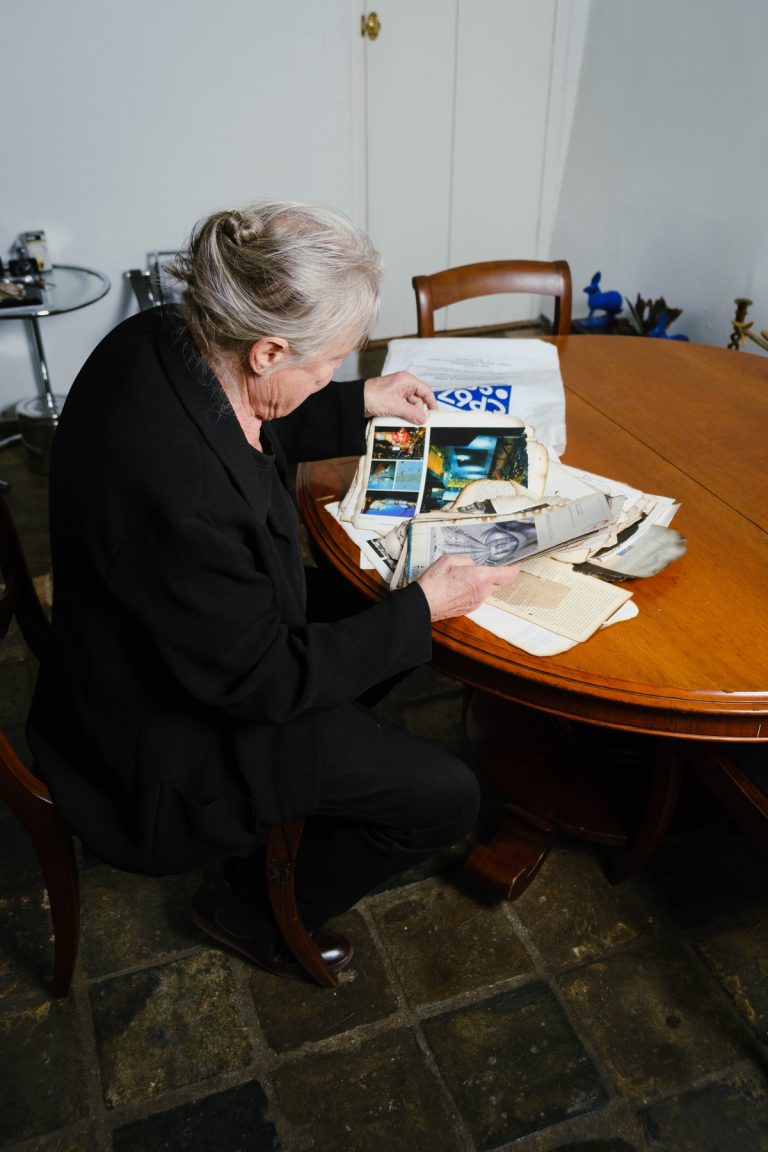The Faculty of Architecture burned down on 13 May 2008. Fifteen years later, people at TU Delft are using objects to look back. Part 1: Franziska Bollerey’s burnt documents.
Franziska Bollerey suffers to this day from the loss of her personal archive. (Photo: Jaden Accord)
For the Professor of History of Architecture and Urban Planning they symbolise loss: the postcards, A4s, historic documents and handwritten letters with blackened edges. In her living room on Oude Delft she carefully takes a pile of papers from a white plastic bag. They are still legible, but she cannot do much with them. They are “after all, individual sheets of paper and not consecutive documents”. Yet, she is unable to get rid of them.
Bollerey lost her entire personal archive in the fire. This includes the historic documents that she collected on women in architecture for 30 years. “There is now more attention being paid to female pioneers, but when I was one of them, there were few who did so.” And her written exchanges with well-known persons from the history of culture and architecture. “I corresponded a lot with people like Harald Szeemann, a famous Swiss curator, and Cornelis van Eesteren, an expert in urban planning. He designed the urban plan for TU Delft’s campus.” Her personal archive consists of ‘many metres’ of archive cupboards.
Not birds
The pile of burnt documents are just one of the few surviving parts of her historic collection. They were found after the fire by people in Delft and its surroundings. They handed over the blackened papers to her or posted them. ‘Dear Professor, we can imagine that you would like to have these back’, is handwritten on a letter that someone sent with a postcard that they found. Some papers were even found in Rotterdam and made their way back to Delft.

Bollerey and her boyfriend Axel first spotted the fire from the roof of the Library. “He suddenly asked why there were so many birds flying around the Faculty. When we looked more closely we saw that they were not birds at all, but pieces of paper flying around. There were hundreds of them.” They then went home. Sitting at home was better than watching helplessly.
Later in the day the phone rang. It was a journalist asking if she would come to the Faculty of Architecture and the Built Environment to give an interview about the Faculty’s historic chair collection. After two more phone calls she gave in went back to the burning building. “I shouldn’t have done so,” she sighed. “The fire was too emotional for me.” That evening the whole country saw the building collapsing and Bollerey bursting into tears.
A photo of Bollerey crying with Axel’s arms wrapped around her appeared on all the front pages. “The NRC, Volkskrant newspapers and more.” For weeks after the fire strangers spoke to her in the street. “You’re the lady of the Architecture and the Built Environment fire, aren’t you?” they asked. She still has the photo that appeared in all the newspapers.
Writing without an archive
Bollerey suffered for years after the fire. Not only emotionally, but practically too. “In the months following the fire when people asked me for lectures, presentations or academic publications, I always immediately said yes, only to discover that I no longer had the right historic documents.” She even still endures this up to this day. “I recently wrote a chapter for a book about women in Central European architecture. The documents that I had collected since my student time would have been very useful.”
But the disaster brought her new things too. About two months after the fire she wrote to universities and colleagues around the world, asking them if they had any spare books and slides. While a lot of books were saved from the general library at Architecture and the Built Environment, her research institute, the Institute of History of Art, Architecture and Urbanism (IHAAU), lost hundreds of books, tens of thousands of slides, and dozens of metres of historic archives. Masses of acquaintances from the academic world and other professionals paid heed to her plea. For months after the fire, boxes with books arrived from all over Europe. “That was on top of all the people who brought those burned pieces of paper. It was amazing.”
The fire is no longer an emotionally charged issue, she says. “In the end, it would be far worse to lose someone you love than your intellectual life.” Memories of the fire rise to the surface once in a while. Such as when writing an academic publication. Or last February when she was waiting for a train at Delft station. A stranger kept staring at her. “I smiled at her and she said that she knew me from somewhere. She suddenly remembered and exclaimed ‘You’re the woman from the fire at Architecture and the Built Environment, aren’t you?’ Can you imagine. Fifteen years later I’m still associated with the inferno.”
Do you have a question or comment about this article?
a.m.debruijn@tudelft.nl


Comments are closed.